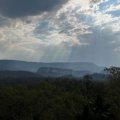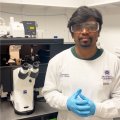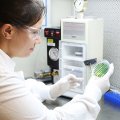University of Queensland researchers believe further work is urgently needed to analyse data on tide, wind and wave conditions at Heron Island, one of the most popular resort destinations in Queensland's Great Barrier Reef.
Honorary research consultant in the Civil Engineering Department Dr Michael Gourlay said it was important for future tourist activities on the island that monitoring of the impact of man-made structures on the natural island and reef environment was continued.
'Difficulties are often experienced when tourist and other facilities and their infrastructure are located on small reef-top islands and their surrounding coral reefs,' he said.
Dr Gourlay and senior research assistant Mrs Jenny Hacker have developed an understanding of the reef-top hydrodynamics at Heron Island, and of the impact of the island's harbour bund walls, following a four-year study funded through the Great Barrier Reef Marine Park Authority.
They are analysing data from sophisticated instruments installed in March 1996 to measure wave and current conditions but funding has run out on this study, which requires two years' more work.
'Without considerable research to understand the processes and produce accurate conceptual models it is difficult to solve problems without creating new ones,' Dr Gourlay said.
'It appears that the island is getting smaller as Casuarina trees around the shoreline have been lost because of erosion. Department of Environment and Heritage studies some time ago showed that another Great Barrier Reef island, Green Island, was losing 1000 cubic metres of sand a year.
'However, we do not know at Heron Island if the creation of new sediment through the death of marine organisms is sufficient to replace sand lost through severe events such as tropical cyclones, or through subtle, longer-term changes.
'During Tropical Cyclone Rewa in January 1994, some concrete blocks, weighing 1.2 tonnes each, were moved up to 12 metres towards the boat harbour by current and wave action on the reef-top. Reef-top sediments were also deposited in the boat harbour during this event. Sediments deposited in the boat harbour can only be returned to the island by dredging or similar artificial means.'
Dr Gourlay, who has been conducting research and supervising student projects at Heron Island since 1979, said the current project indicated the situation was more complex than previously assumed.
'Heron Island in the Capricornia group of reefs, north-east of Gladstone, is a reef-top island or coral cay which is a special class of coastal land formed of sediments entirely of biogenic origin in very recent geological time,' Dr Gourlay said.
'Coral cays are potentially transitory in nature. Islands are small and the reef-tops extensive, so changes in sediment transport rates, volumes and bottom elevations are also often small, requiring very accurate measurements.'
Reef-top hydraulics and the cay's coastal processes were complex and had to be considered as a three dimensional system rather than simple along-shore/offshore processes usually associated with mainland coasts.
Dr Gourlay said the boat harbour was built at the island's western (leeward) end to allow access. A gap in the reef rim was blasted in 1945 with the harbour first dredged in 1967 and enlarged in 1987. Construction of the harbour through the reef-rim allowed water to drain off the reef through the harbour entrance channel at low tide.
This had two important adverse effects: it reduced the water level on the reef-top during low tide affecting much of the reef-top biota; and it changed the pattern of reef-top currents, so they flowed into the harbour for a substantial part of the tidal cycle. This caused coarser sediments to be deposited in the harbour and finer sediments to be carried through the entrance channel and deposited beyond the reef-edge.
In 1993-94 low bund walls were constructed of concrete blocks along both sides of the boat harbour to prevent loss of water from the reef-flat at low tide. Dr Gourlay and Mrs Hacker measured the influence of the bund walls on water levels on the reef-flat during low tides before, during and after construction and found the walls had controlled the water level at low tide satisfactorily.
Coral growth near the boat harbour was measured as part of several Environmental Engineering student projects and it has been found that in the past few years the coral species along both sides of the boat harbour have grown in response to the raised low-tide water levels resulting from the bund wall construction.
Fast-growing species such as Acropora have almost completely accommodated the 0.14 metre rise in low-tide water level, while slower-growing species such as Porites are taking longer to catch up.
Dr Gourlay said studies of the island's reef-top hydrodynamics have shown that currents measured on Heron Island near the boat harbour exhibited an intricate pattern of reversals when controlled by the tide alone. A current meter situated to the north of the boat harbour showed four reversals during one tidal cycle. Under conditions of strong winds and large off-reef waves, the normal current reversal pattern was suppressed and currents on the windward side of the island were directed towards the boat harbour for the duration of the event.
This preferred current direction at such times was capable of transporting reef-top sediments into the boat harbour, causing depletion of sediment reserves and erosion on the island. It was probable that conditions of this type, enhanced by wave action on the reef-top, moved the 1.2 tonne blocks during Tropical Cyclone Rewa.
Dr Gourlay said the completion of the research should determine the magnitude and frequency of occurrence of events causing sediment inflow to the boat harbour. Once these were known, decisions could be made as to whether this problem was best dealt with by removing the sediment after the event, or by further modifications or additions to the boat harbour and its bund walls.
Dr Gourlay said research had been conducted with significant assistance from the University's Heron Island Research Station, University staff and students in several departments, and from overseas universities. Support from P&O Heron Island Resort and the Queensland Department of Environment and Heritage had been essential in bringing the project to its present stage.
Associate Professor John Jell of the University's Earth Sciences Department has been involved with the studies over many years, and Dr Gerd Dowideit of the University's Geographical Sciences and Planning Department is currently pioneering new underwater photogrammetric methods for hydrographic surveys in the harbour and entrance channel.
For further information, contact Dr Gourlay, telephone 07 3365 3913 or Mrs Hacker telephone 07 3365 3914.
.jpg)



